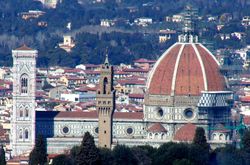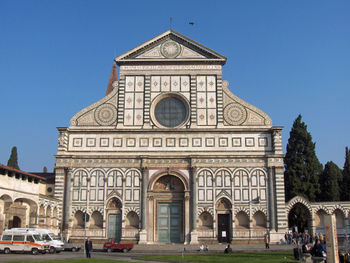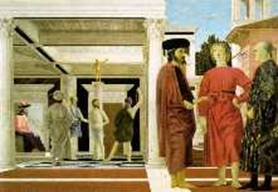Dr. Anthony Costantini
Italian Section Head
Italian Language and Culture
Perspective in Renaissance Art in Italy
What is perspective?
Perspective is defined as “parallel lines converging to a single point: this point is called the vanishing point.”
Giotto di Bondone (1277-1337) is considered the father of perspective. He was a born in the village of Colle di Vespignano, north of Florence. Along with other artists of his time, he painted the frescos of the Arena Chapel in Padua (around 1306), the “Enthroned Madonna” (1310), and the frescoes of the Bardi Chapel in the Church of Santa Croce in Florence (1320).
Giotto – Madonna and Child Enthroned
After Giotto di Bondone, a series of great artists (who either were born in Florence or practiced their art in Florence) worked with the concept of perspective and its applications:
Filippo Brunelleschi (1337-1446) - was the architect who supervised the building of the Cupola of Florence Cathedral

Brunelleschi – Cupola del Duomo di Firenze
Leon Battista Alberti (1404-1472) - wrote the treatise on painting: Della Pittura (On Picture). He designed the façade of Santa Maria Novella in Florence and the Church of Sant’Andrea in Mantua.

Alberti - Santa Maria Novella - Florence
Masaccio (1400-1428) - at age 27, he painted the fresco in Santa Maria Novella in Florence called the ‘Trinity’.
http://www.wga.hu/detail/m/masaccio/trinity/trinity.jpg
Piero della Francesca (1410?-1492) - was a brilliant mathematician, applied mathematical rules to perspective. He was also a great painter, ‘The Flagellation of Christ’ (1444), ‘The Baptism of Christ’ (1445), and the ‘Resurrection” (1450).

Piero della Francesca - The Flagellation of Christ
Paolo Uccello (1397-1475) - he preferred drawing at night than going to sleep- He drew the famous “Perspective Study of a Chalice” and painted “Battle of San Romano’ (1445).
Uccello - Perspective Study of a Chalice
Andrea Mantegna (1431-1506) - painted the “Dead Christ” (1466) and the famous fresco of the ceiling of the “Camera degli Sposi” in the Palazzo Ducale of Mantua (1465-1474).
Mantegna - Dead Christ
Leonardo da Vinci (1452-1519) - elaborated the “perspective of dissolvence.” He noticed that the sky tends to become bluer in the distance pending the thickness of the interposed clouds. Among his many masterpieces are the “Madonna of the Rocks” (1483), “The Last Supper” (1495-97), and “Mona Lisa” (1503).
Da Vinci – Madonna of the Rocks
Raphael (1483-1520) - Developed what can be called a perspective with theatrical effects. He painted the “Transfiguration of Christ” ( 1517), “The liberation of Saint Peter from Prison” (1513), and the famous “School of Athens” (1510-1511).
Raphael – Transfiguration of Christ
Michelangelo (1475-1564) - architect, sculptor, and painter. He is most famous for painting the ceiling of the Sistine Chapel. Click on link below to view full image of the Sistine Chapel ceiling
http://history.hanover.edu/courses/art/micsis3.jpg
Source: http://www.csun.edu/~hffll002/Perspective%20in%20Renaissance%20Art%20in%20Italy%20rev%20pm.doc
Web site to visit: http://www.csun.edu/
Author of the text: indicated on the source document of the above text
If you are the author of the text above and you not agree to share your knowledge for teaching, research, scholarship (for fair use as indicated in the United States copyrigh low) please send us an e-mail and we will remove your text quickly. Fair use is a limitation and exception to the exclusive right granted by copyright law to the author of a creative work. In United States copyright law, fair use is a doctrine that permits limited use of copyrighted material without acquiring permission from the rights holders. Examples of fair use include commentary, search engines, criticism, news reporting, research, teaching, library archiving and scholarship. It provides for the legal, unlicensed citation or incorporation of copyrighted material in another author's work under a four-factor balancing test. (source: http://en.wikipedia.org/wiki/Fair_use)
The information of medicine and health contained in the site are of a general nature and purpose which is purely informative and for this reason may not replace in any case, the council of a doctor or a qualified entity legally to the profession.
The following texts are the property of their respective authors and we thank them for giving us the opportunity to share for free to students, teachers and users of the Web their texts will used only for illustrative educational and scientific purposes only.
All the information in our site are given for nonprofit educational purposes
The information of medicine and health contained in the site are of a general nature and purpose which is purely informative and for this reason may not replace in any case, the council of a doctor or a qualified entity legally to the profession.
www.riassuntini.com